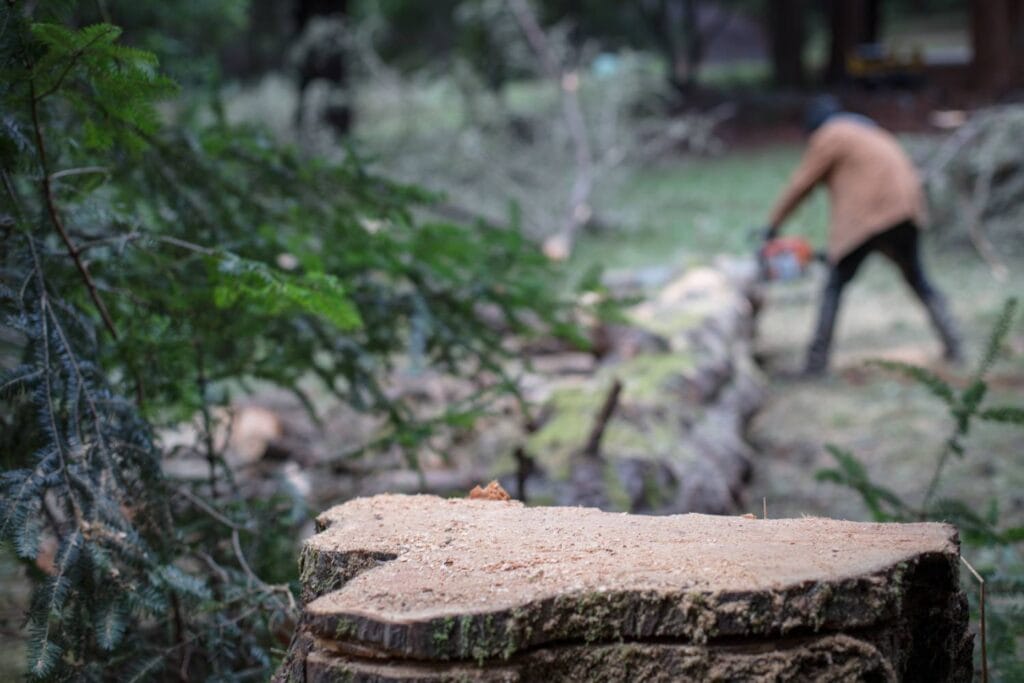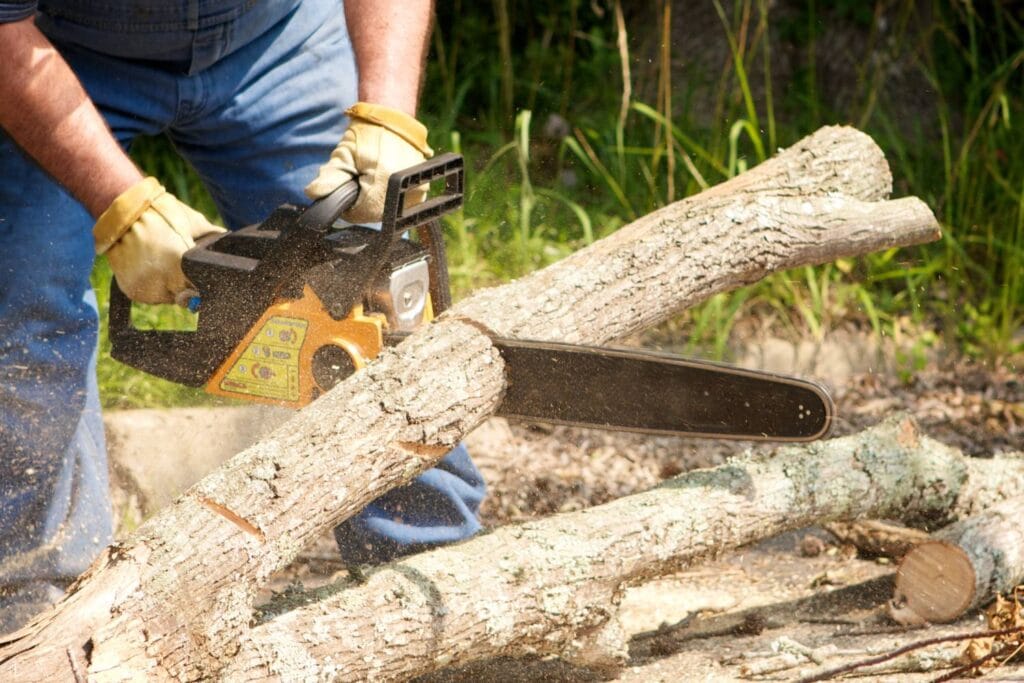Tree cutting, whether by professional arborists or DIY enthusiasts, involves a range of skills and knowledge to ensure safety and efficiency. This guide covers the key aspects of tree cutting, from essential safety gear to proper planning and tool maintenance. By mastering these skills, you can confidently and safely tackle tree-cutting tasks.
What Safety Gear Do I Need For Tree Cutting?
Tree cutting is a hazardous activity that requires the right equipment and precautions to ensure safety. Whether you’re a professional arborist or a DIY enthusiast, wearing appropriate safety gear can significantly reduce the risk of accidents and injuries. Below is a comprehensive guide to essential safety gear for tree cutting, derived from expert sources to ensure your protection.

Head Protection
Head protection is vital when cutting trees due to the risk of falling branches and other debris. A hard hat is essential to protect your head from impacts. For added protection, especially when using loud power tools, consider a helmet that includes ear protection. This dual-purpose helmet will safeguard both your head and hearing, ensuring you are protected from everyday impacts and prolonged exposure to loud noises.
Eye And Face Protection
Protecting your eyes and face is crucial to avoid injuries from dust, wood chips, and other flying debris. Safety glasses or goggles are necessary to shield your eyes, providing a barrier against small particles. For additional safety, especially when working with power tools that can cause larger debris or kickbacks, wearing a face shield offers enhanced protection, covering your entire face and preventing serious injuries.
Hearing Protection
Prolonged exposure to the loud noises of chainsaws and other equipment can lead to hearing damage. To prevent this, it is important to use ear muffs or ear plugs. Ear muffs provide a secure seal around your ears, effectively muffling loud noises, while disposable earplugs can be used for convenience and are designed to be discarded after each use. Both types of hearing protection are essential for maintaining your hearing health.
Hand Protection
Your hands are at high risk of injuries from cuts, punctures, and vibrations during tree cutting. Wearing leather lineman’s gloves can provide the necessary protection. These gloves are designed to protect your hands from sharp objects and minimise the impact of vibrations from power tools, ensuring you maintain a secure grip while reducing the risk of hand injuries.
Foot Protection
Proper footwear is essential to ensure stability and protect your feet from potential hazards. Steel-toed boots with non-slip soles offer the best protection. These boots provide a firm footing on various surfaces, reducing the risk of slips and falls. Additionally, the steel toe protects against injuries from falling objects, making them indispensable for tree cutting activities.
Body Protection
Wearing chainsaw-resistant clothing is crucial. This specialised clothing, which includes chaps or trousers made from cut-resistant materials, helps protect against accidental contact with the chainsaw blade. In addition to chainsaw-resistant gear, wearing long-sleeved shirts and pants can protect your skin from scratches, insect bites, and other minor injuries, ensuring you remain safe while working.
Climbing Equipment
For those working at heights, proper climbing equipment is essential. A safety harness ensures you are securely attached to the tree, preventing falls. Along with the harness, using climbing ropes, belts, carabiners, and slings provides secure attachment points and mobility, allowing you to manoeuvre safely and efficiently while performing tree-cutting tasks.
How Do I Properly Plan A Tree Cutting Operation?
Properly planning a tree cutting operation is crucial to ensure safety and efficiency. This guide outlines the essential steps to prepare for and execute tree felling effectively.
Plan Ahead
Planning ahead is vital for a successful tree cutting operation. Start by assessing the site for any major obstacles such as overhead lines, roads, or buildings. If necessary, place warning signs to alert others of potential hazards. Additionally, determine the characteristics of the tree, including its height, lean, and potential hazards. Tools like clinometers or the “stick trick” can help estimate the tree’s height. Consider the wind direction, as it can significantly affect the tree’s fall.
Check The Felling Direction
Carefully study the tree to determine its felling direction. Observe the branches and their growth direction, and use a plumb line to verify the tree’s natural fall direction. Clear the area around the tree to remove any obstacles. Ensure you have a clear path of retreat at a 45-degree angle from the intended felling direction to enhance safety.
Prune The Trunk
Before cutting, prune the trunk to remove branches and twigs up to shoulder height to prevent interference during the operation. Check that your chainsaw has enough fuel for the entire task to avoid interruptions.
Decide On Cutting Technique
Choosing the right cutting technique is crucial for a safe operation. An open-faced notch, cut at a 70-90 degree angle, offers better control and is generally safer than a conventional notch. The notch helps guide the tree’s fall. Ensure the felling wedge or breaking bar is inserted before completing the cut to prevent the tree from pinching the guide bar. The technique used should depend on the tree’s size and the length of your chainsaw bar.
Check For Diseases
Inspect the tree for signs of disease or rot. Look for discoloured or softwood, which can indicate weakened fibres. If the tree appears diseased, take extra precautions. It may be necessary to fall the tree in its natural direction of fall and use a winch for added safety. Rot typically subsides higher up the tree, so consider leaving an extra-high stump if necessary.
Choose Your Tool
Selecting the appropriate tools is essential for effective tree felling. For small trees, hand force may be sufficient, but larger trees may require felling wedges or a winch. Ensure you have all necessary safety equipment, including personal protective equipment (PPE) such as a hard hat, eye protection, ear protection, chaps, and appropriate boots. Maintain your chainsaw, keeping it sharp and ensuring the engine is powerful enough for the task. Additional tools like wedges, an axe or hammer, and a rope or mechanical advantage should be on hand.

What Techniques Are Used To Make Accurate Cuts?
Utilising The Right Tools
Investing in high-quality measuring tools, such as rulers, tape measures, and squares, is essential for accurate cuts. The precision of these tools directly influences the accuracy of your cuts. For small and intricate pieces, callipers are invaluable as they can measure very fine dimensions, providing greater precision and detail in your work.
Tips For Using Saws
When using a mitre saw, selecting the appropriate blade is crucial. Blades with more teeth provide cleaner cuts, which is important for precision. Always secure the workpiece with clamps to prevent any movement during the cut, ensuring a straight and clean result.
Before making a cut, check the mitre and bevel angles to confirm they are set correctly. Additionally, when cutting, position the blade on the waste side of the line to maintain the exact dimensions of the piece. For general saw use, keeping your blades sharp is essential to avoid splintering and achieving clean cuts. It’s also important to maintain a controlled cutting speed to avoid mistakes.
Techniques For Perfect Cuts
Performing test cuts on scrap pieces is a useful practice to ensure your settings and measurements are correct before working on the actual piece. Using jigs, which can be custom-made to guide your saw or router for repetitive cuts, significantly increases accuracy.
When cutting along the grain, ensure your blade is sharp and move slowly to avoid tearing the wood. Maintaining a stable stance and firm grip on your tools is crucial for controlled and accurate cuts.
Conclusion
Tree cutting requires meticulous safety measures and proper techniques, whether you’re a professional arborist or a DIY enthusiast. Essential safety gear, such as head protection, chainsaw-resistant clothing, and proper footwear, is crucial in minimising risks.
Effective planning, including assessing the tree and site, selecting the right tools, and mastering precise cutting techniques, ensures both safety and efficiency. Proper maintenance and use of tools, especially chainsaws, are vital for preventing accidents. By following these guidelines, you can confidently and safely undertake tree-cutting tasks, prioritising safety and precision for successful results.
Frequently Asked Questions
What Safety Equipment Is Necessary For Tree Cutting?
To ensure safety while cutting trees, you should always wear appropriate protective gear. This includes a hard hat to guard against falling branches, safety goggles to shield your eyes from debris, and ear protection to mitigate the loud noise produced by chainsaws. Additionally, gloves are essential for improving grip and protecting your hands, while chainsaw chaps or cut-resistant pants provide crucial leg protection. Lastly, sturdy, non-slip boots are necessary to maintain proper footing and prevent accidents.
What Are The Basic Steps For Cutting Down A Tree Safely?
Safely cutting down a tree involves several critical steps. First, assess the area to ensure it is clear of obstacles and people. Plan the felling direction by determining where you want the tree to fall. Next, create a V-shaped notch cut on the side of the tree facing the fall direction, ensuring it is the correct size and angle. On the opposite side, make a horizontal felling cut slightly above the bottom of the notch cut. As the tree begins to fall, retreat quickly to a safe distance to avoid any potential hazards.
How Can I Properly Maintain My Chainsaw For Effective Tree Cutting?
Proper maintenance of your chainsaw is essential for effective tree cutting. Regularly sharpening the chain ensures efficient cutting while maintaining the correct chain tension prevents accidents and wear. Keeping the bar and chain properly lubricated reduces friction and extends the tool’s lifespan. Additionally, cleaning the air filter and chainsaw body removes debris that can affect performance. Periodically inspecting and tightening any loose parts ensures the chainsaw operates safely and efficiently.
What Techniques Can Help Prevent A Tree From Splitting Or Barber-Chairing During Cutting?
Preventing a tree from splitting or barber-chairing involves several techniques. Ensure the notch cut is made correctly with the proper angle and depth, as this directs the fall and reduces stress on the tree. The felling cut should be straight and at the right height relative to the notch cut to maintain control. Using wedges can help guide the tree and keep the cut open, providing additional control. It is crucial to avoid cutting trees under tension or those with visible cracks, as these conditions increase the risk of splitting.
What Are The Signs Of A Potentially Hazardous Tree, And How Should I Approach Cutting It?
A potentially hazardous tree may exhibit several warning signs, such as large dead branches, decayed wood, cracks or splits in the trunk or branches, significant leaning, or fungal growth at the base or along the trunk. When dealing with a hazardous tree, a thorough assessment is necessary before starting the cutting process. Use ropes and wedges to control the fall direction and ensure safety. Given the increased risks, consulting or hiring a professional is advisable for trees that are particularly difficult to assess or pose significant hazards.

